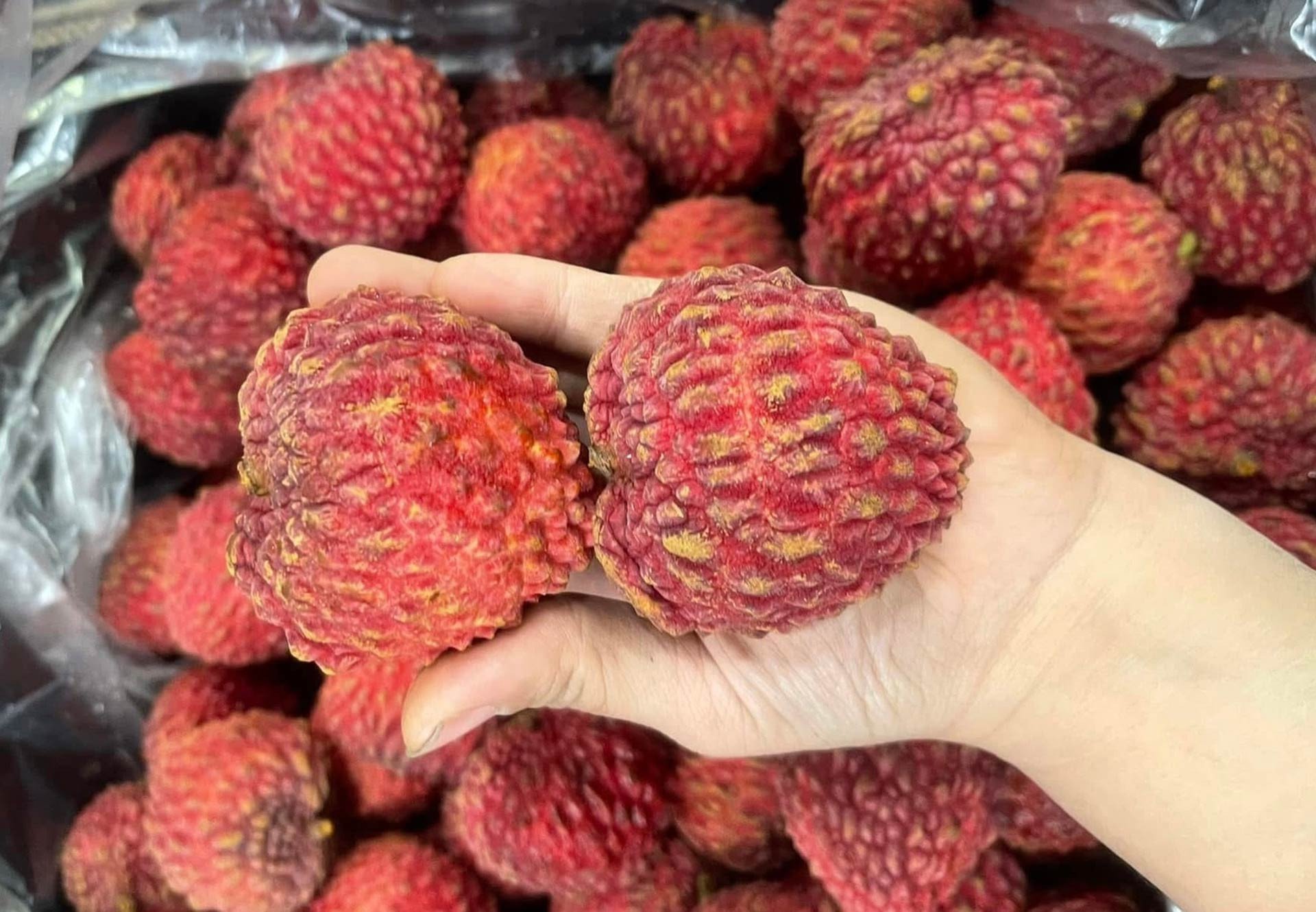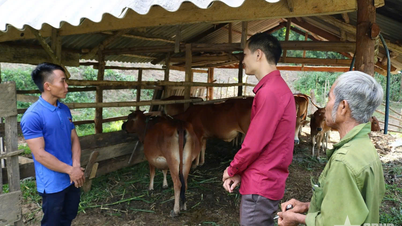Australian lychees cost 6 million VND/box, imported 'princess' strawberries from Japan cost nearly 7 million VND/kg and are still 'sold out'. Meanwhile, Chilean cherries sold in Ho Chi Minh City are at an unprecedentedly low price, many people suspect they are Chinese goods.
Chilean cherries are surprisingly cheap, suspected to be Chinese goods
For more than ten days now, the Ho Chi Minh City market has been flooded with imported cherries at unprecedentedly low prices, causing many buyers to suspect that these are Chinese goods.
Nguoi Lao Dong reporters surveyed many cherry selling points and found that many places are advertising cherries at the "cheapest price in history". Customers can buy them for only 150,000 VND/kg with full packaging stating their origin is Chile.
Explaining why Chilean cherry prices are cheaper than every year, a Farmer Market representative said that there are currently many imported goods and weak purchasing power, so suppliers have to deeply discount to push sales.
A representative of a major fruit importer confirmed that it is cherry season in the Southern Hemisphere countries of New Zealand, Australia, and Chile. China also grows cherries, but in small quantities and harvests them in the summer, the same season as American and Canadian cherries.
'Princess' strawberries cost nearly 7 million VND/kg but are still in high demand
Strawberries are in harvest season and are widely available in stores and supermarkets. According to Tien Phong Newspaper, currently on the market, Moc Chau, Son La strawberries are being sold at an average price of about 200,000-800,000 VND/kg, depending on the size and quality of the strawberries. Strawberries of size 20-24 are being sold at some stores for nearly 700,000 VND/kg.
However, on the occasion of Tet At Ty, the demand for giving high-class, luxurious products has increased. Many people have spent 6-7 million VND to buy 1kg of "princess" strawberries imported from Japan as gifts.
Although much more expensive than other types of strawberries currently available in the country, this item is still bought by many people, and some places even report being "out of stock" continuously.
Appearing at Tet market, Australian lychee costs nearly 6 million VND/box
Vietnam is a world-famous country for growing and exporting lychees. In the Vietnamese market, lychees are a popular fruit. However, fresh lychees in our country are only available in the summer, and in other seasons of the year they are imported goods with extremely expensive prices.
Stores are selling Australian lychees, also known as Australian dragon lychees, at a common price of 1-1.2 million VND/kg. This price has put Australian lychees on the list of the most expensive fruits in the Vietnamese market during the Lunar New Year.
Currently, a 5kg box of lychees bought as a Tet gift costs 5-6 million VND. But this item is still quite popular.

Milk grapes were found to contain toxic substances in Thailand, but goods still poured into Vietnamese markets at super cheap prices.
In recent years, milk grapes - a high-class grape variety that traders call "noble goods" - have flooded the Vietnamese market, sold everywhere in the streets, traditional markets, and online markets at increasingly cheap prices.
Notably, not long ago this type of Chinese milk grape in Thailand was discovered to contain many toxic substances.
After Chinese milk grapes were involved in a scandal of toxic substances, many Vietnamese consumers expressed their concern about this fruit. Shop owners also admitted that milk grapes are less popular than before, despite having attached a “plant quarantine certificate”.
However, in the days leading up to Tet At Ty, milk grapes still flood Vietnamese markets, being sold in abundance on large and small online markets at super cheap prices.
“Today, the VIP grape batch arrived, the stems are still fresh, the fruit is big, green, shiny, crispy and has a light sweet milky aroma, but the price is only 100,000 VND/bunch. Buying retail by bunch is 40,000 VND/kg”, said Ms. Nguyen Thi Thanh Tuyet - selling milk grapes in Ha Dong (Hanoi), adding that this is the cheapest imported grape batch ever sold.
Peach and kumquat trees for Tet are criticized for being unattractive, a 'rather strange' item suddenly becomes popular
Due to the prolonged impact of natural disasters, this year's peach and kumquat designs are not considered beautiful by buyers. Purchasing power is also much lower than previous years, making traders nervous. Meanwhile, another product is doing better.
A peach vendor at Lac Long Quan market said he imported a few rose branches to "sell for fun", but unexpectedly this type of product was in high demand. "This type of tree seems a bit more unique, easy to arrange, and does not require care. The price for a large branch is only 300,000-800,000 VND, much cheaper than ornamental peach trees, so it is chosen by customers", he said.
Pork prices skyrocket, smuggled goods flood Vietnamese markets, warnings about pigs eating 'banned substances'
The price of live pigs has skyrocketed, reaching the peak of 2024 as the Lunar New Year approaches. In the market, the price of live pigs has been increasing since mid-December 2024. Currently, in localities, this item has increased to 66,000-70,000 VND/kg. This has led to an increase in the price of pork at the main dealers by 10,000-20,000 VND/kg depending on the type compared to half a month ago.
Meanwhile, the price of this item in neighboring Cambodia is low, so smuggled goods, pigs fed with 'banned substances', and pigs infected with diseases flood into Vietnamese markets.
Rice prices in Tien Giang drop sharply
In recent days, many people have come to rice mills and processing plants in Tien Giang province to buy rice for storage, because rice prices are falling sharply.
According to Tien Phong reporters' records on January 17, along Provincial Road 868 (Cai Lay town), many rice mills displayed rice on the roadside and hung up discount signs. Regular rice was sold for VND600,000/bag, fragrant rice for VND750,000/bag of 50 kg. This price was about VND200,000 lower per bag than it was more than a week ago.
Mr. Luu Van Phi - Director of Tien Giang Department of Industry and Trade - said that in recent days, rice prices have decreased by about 2,000 VND/kg compared to before. The main reason is that the rice export market is facing difficulties. After a period of stopping rice exports, India has now opened its doors and released a large amount of rice into the market.
Source: https://vietnamnet.vn/vai-thieu-uc-gan-6-trieu-dong-hop-dau-tay-nhat-7-trieu-dong-kg-van-chay-hang-2364683.html







![[Photo] Prime Minister Pham Minh Chinh chairs Government Standing Committee meeting on Gia Binh airport project](https://vphoto.vietnam.vn/thumb/1200x675/vietnam/resource/IMAGE/2025/5/10/6d3bef55258d417b9bca53fbefd4aeee)


























![[Photo] General Secretary To Lam holds a brief meeting with Russian President Vladimir Putin](https://vphoto.vietnam.vn/thumb/1200x675/vietnam/resource/IMAGE/2025/5/10/bfaa3ffbc920467893367c80b68984c6)

































































Comment (0)